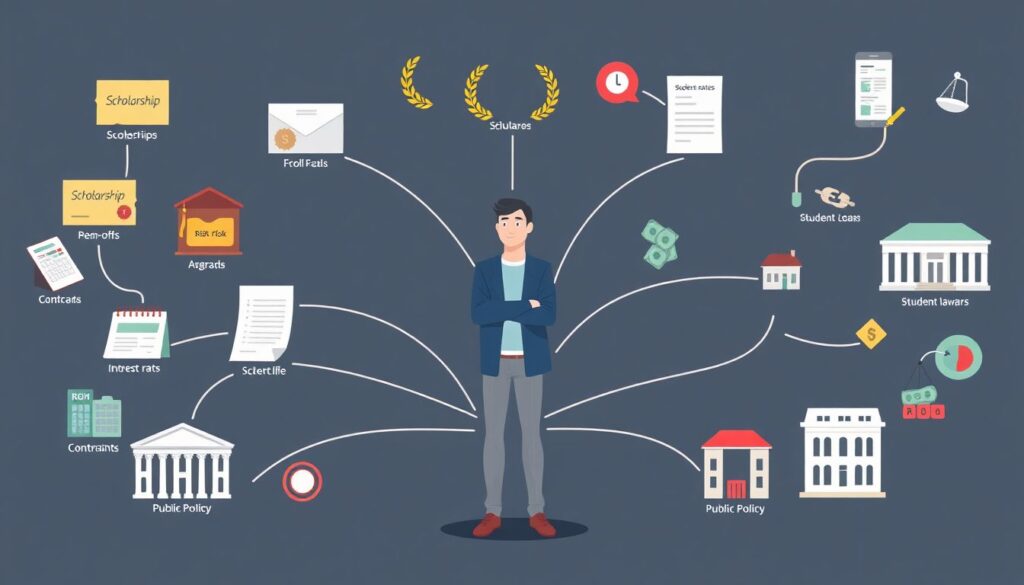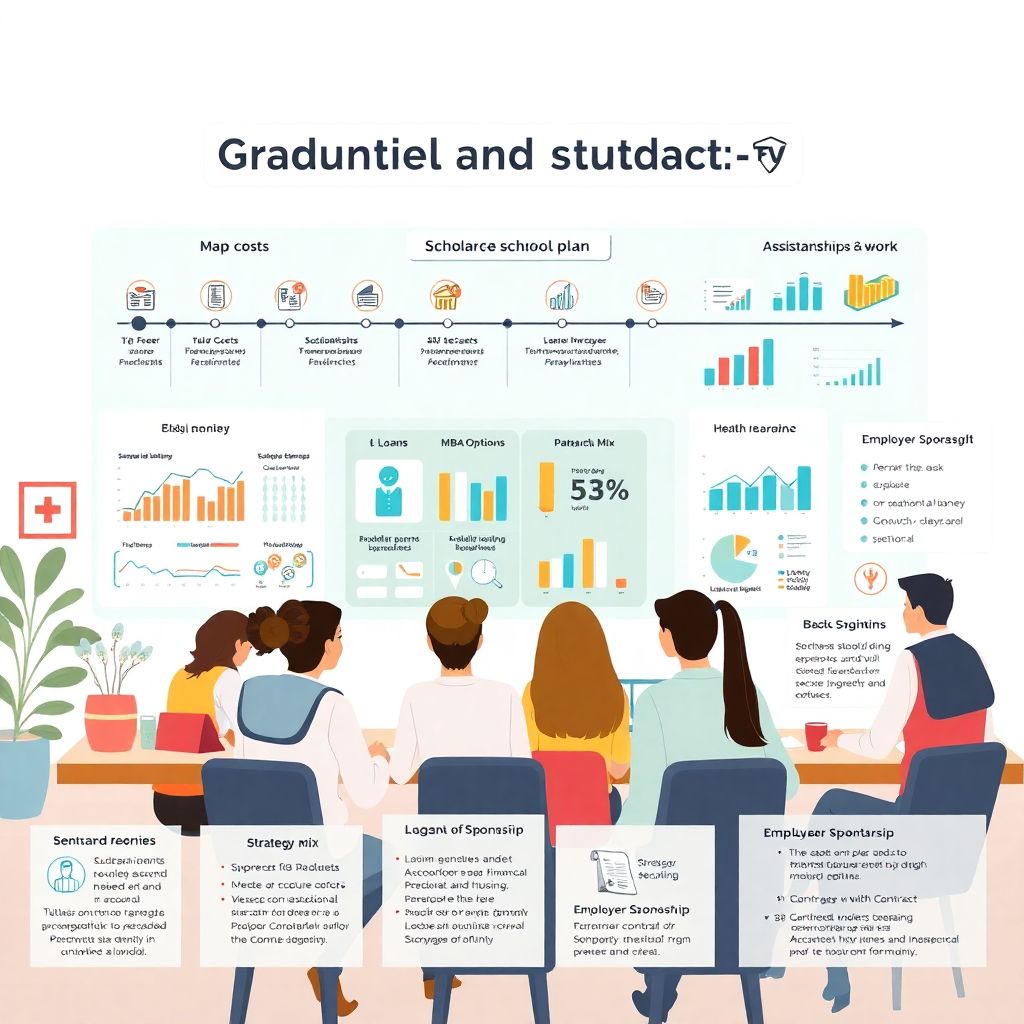Understanding the Big Picture: What “Financial Aid” Really Means
When people talk about “financial aid for grad school”, they often imagine a single form that magically spits out free money. In reality, graduate school financial aid options are a mix of different instruments: need‑based support, merit‑based awards, federal and private loans, employer assistance, teaching or research assistantships, and sometimes school‑specific discounts. Each of these tools has its own rules, timelines, and trade‑offs, and the smartest way to navigate them is to treat grad school like a multi‑year financial project, not a one‑time purchase. Before you compare programs, it is worth defining your total cost of attendance (tuition, fees, books, housing, transport, health insurance, interest on debt) and your risk tolerance: how much debt you can realistically handle without sabotaging your future choices in career and lifestyle.
Step 1: Map Your Costs and Your Timeline
The first practical move is to calculate, as soberly as possible, how much the degree will actually cost you over the full program length. Schools usually show only tuition and mandatory fees, but your budget must also include rent, food, commuting, technology, and relocation. Collect this data for each program you are considering, then align it with program duration and your expected ability to work while studying. A two‑year degree with a generous stipend may end up cheaper than a one‑year “intensive” program that forces you to quit your job entirely. If you do this early, you can see where you need more scholarships, how many working hours you must realistically plan for, and where taking on debt becomes unavoidable instead of optional.
Common mistake at this stage
Many applicants underestimate living costs by assuming they will “tighten the belt somehow”, but vague optimism is not a financial strategy. Underbudgeting by even a few hundred dollars a month can push you toward high‑interest credit cards mid‑semester, which is much more expensive than carefully planned borrowing. Another recurring error is ignoring opportunity cost: years out of the workforce or stuck in low‑pay part‑time roles also affect your long‑term net worth, so they should be part of your initial comparison between schools and study formats.
Step 2: Start with “Free Money”: Scholarships, Grants, and Fellowships

Before you even think about debt, you want to maximize graduate school scholarships and grants, since they do not require repayment and directly reduce your need for borrowing. Most universities have both central funding and department‑specific awards, and the deadlines for these can precede admission decisions, which means you should research them in parallel with your applications. External fellowships from governments, foundations, and professional associations can be competitive, but they often come with prestige and networking benefits in addition to cash. Think of these resources as equity‑like funding for your degree: they dilute your reliance on leverage, making your future financial structure safer.
How to find and evaluate awards
A pragmatic approach is to create a spreadsheet listing every possible scholarship, grant, and fellowship with eligibility criteria, award size, competitiveness, and application deadlines. Prioritize those that align tightly with your profile: field of study, nationality, demographic background, or career goals. For example, STEM fields often have niche fellowships, while social impact or public policy programs attract philanthropic grants. When comparing overlapping offers, consider not only the headline amount, but also whether the award is renewable, whether it imposes work or research obligations, and whether it restricts your ability to take paid employment during the program.
Newbie tips and frequent pitfalls
New applicants often assume that scholarships are only for “top 1% geniuses” and do not apply widely enough, effectively self‑selecting out of free money. Another issue is treating motivation letters as generic, copy‑paste documents, which weakens your case where selection committees explicitly care about mission fit. Finally, many people ignore small awards because they seem trivial compared to tuition, but stacking several minor grants can meaningfully cut your borrowing needs across two or three years of study.
- Track every scholarship and grant in a single file with status notes so you do not miss hidden or rolling deadlines.
- Reuse core application materials, but adapt them carefully to each funder’s specific criteria and priorities.
- Verify whether awards affect your eligibility for institutional aid or trigger adjustments in your school’s own offers.
Step 3: Compare Work‑Based Funding: Assistantships, Part‑Time Jobs, Employer Support
Once you have squeezed the grant and scholarship sponge, the next lever is income you can earn during the program. Assistantships (teaching or research), campus jobs, and employer tuition benefits are effectively alternative financing mechanisms that can be superior to loans if they fit your schedule and academic workload. With assistantships, you provide academic labor in exchange for tuition reductions, stipends, or both, transforming your time and skills into direct offsets against your cost of attendance. Employer support, on the other hand, usually involves partial tuition reimbursement in exchange for a commitment to remain with the company for a certain period.
Assistantships vs. outside work
An assistantship is typically integrated into your academic environment, which can reinforce your CV and professional network, but the compensation might not match market wages. External part‑time work, especially in high‑pay sectors, can sometimes pay more per hour, yet it increases time fragmentation and commute burdens. From a financial planning standpoint, assistantships reduce your explicit tuition bill (which also lowers the base on which loans might accrue interest), while external jobs simply inject cash that you can allocate as needed. When comparing these routes, consider not just gross pay, but scheduling flexibility, alignment with your career path, and the potential impact on your grades and completion time.
Employer tuition assistance and its trade‑offs
Employer funding can be very attractive because it effectively turns your company into your primary sponsor. However, the strings attached are important: many agreements include clawback clauses requiring you to repay the benefit if you leave earlier than a specified period. For some people, this is an acceptable constraint; for others, it feels like golden handcuffs that may restrict job mobility right when the degree should be expanding their options. Carefully read policy documents and discuss them with HR in advance instead of relying on verbal assurances.
Step 4: Decide When and How to Use Loans (if at All)
After exhausting non‑repayable funding and work‑based options, you can more rationally assess how much, if any, debt you need. This is the stage where many students feel overwhelmed by acronyms and marketing talk about the best student loans for graduate school. Instead of chasing whatever product is advertised most aggressively, it helps to distinguish between federal loans (if you are eligible) and private loans, look at their interest rates, repayment structures, and borrower protections, then model realistic repayment scenarios based on your target field’s salary range. Your objective is not to avoid loans at any cost, but to use them strategically while controlling risk.
Federal vs. private loans: a functional comparison
For students who qualify, federal loans often come with income‑driven repayment options, forgiveness programs for certain public‑sector roles, and built‑in hardship protections like deferment and forbearance. Private loans may offer lower initial interest rates in some cases, but they tend to have fewer safety valves if your income is unpredictable. Another axis to compare is whether the loan is unsubsidized (interest accrues during school) and how capitalization works. Over multiple years of study, even small differences in rate or capitalization rules can compound into significant extra costs, so reading the promissory note is not optional paperwork, it is part of your risk management process.
How to pay for graduate school without loans: realistic strategies
Some people are determined to avoid borrowing altogether, which is possible in certain contexts but usually requires a more conservative approach from the start. That might mean choosing lower‑cost public universities, studying part‑time while maintaining a stable job, aggressively stacking assistantships and fellowships, or relocating to areas with lower living costs. The trade‑off is often time and intensity: it may take longer to finish the program, and you might need to decline certain unpaid internships or extracurriculars because your schedule is already dominated by revenue‑generating work. When you compare this loan‑free route with a modestly leveraged approach, ask yourself not only “how much debt will I avoid?” but also “what income or growth opportunities might I be postponing by stretching this process out?”
- If going loan‑free forces you into extreme burnout, the risk of dropping out can become higher than the perceived risk of reasonable borrowing.
- Conversely, if your target field pays modestly, staying out of debt can protect you from long‑term repayment stress that your future salary cannot comfortably absorb.
Step 5: Special Case – Navigating MBA Financial Aid and Funding Options
MBA programs deserve their own discussion because they often come with premium price tags but also high expected returns, which makes the financial calculus more complex. MBA financial aid and funding options usually include merit scholarships, school‑specific fellowships, employer sponsorships for part‑time or executive formats, and a heavier reliance on loans, especially for full‑time programs at top business schools. Moreover, business schools run their own competitive award processes, where a strong profile in leadership, work experience, and standardized tests can make a very large difference in merit‑based aid outcomes.
MBA: loans vs. employer sponsorship vs. self‑funding
Here, the comparison is not only about interest rates but also about career paths. Employer‑sponsored MBAs typically limit your post‑degree choices for a while, but they significantly reduce or eliminate your debt load. Self‑funding through savings and side work offers full freedom afterward but demands very disciplined pre‑MBA preparation, often including several years of aggressive saving and perhaps geo‑arbitrage (working in high‑pay regions while living cheaply). Loan‑funded MBAs allow you to attend sooner and choose roles freely afterward, yet you must be comfortable carrying substantial leverage that depends on continued employment in relatively high‑pay positions. Evaluating these routes means combining quantitative projections (cash flows, repayment timelines) with qualitative factors like your appetite for corporate lock‑in versus entrepreneurial flexibility.
Step 6: Compare Approaches as Complete Strategies, Not Isolated Tactics
Instead of viewing each instrument in isolation, it is more useful to compare entire funding strategies and how they interact with your life and risk preferences. One person might adopt a “scholarships plus modest loans” model; another might pursue a “work‑intensive, no‑loan” strategy; a third might accept “employer‑sponsored but constrained” conditions. Piece by piece, all these frameworks combine the same building blocks but in different proportions to achieve different balances of cost, time, and freedom. The best choice for you is the one whose downside you understand and accept, not the one that looks ideal on paper for someone with different constraints.
Three illustrative funding mixes
Imagine three simplified approaches. Strategy A front‑loads applications for generous scholarships and fellowships, uses a teaching assistantship, and covers the remaining gap with federal loans. This model prioritizes academic alignment and reasonably low stress during study, in exchange for moderate, manageable debt. Strategy B focuses on how to pay for graduate school without loans by choosing a cost‑effective regional university, working nearly full‑time, and taking longer to finish, accepting slower academic immersion but preserving financial flexibility afterward. Strategy C leans on private loans for a prestigious, high‑tuition program, betting aggressively on a big income jump post‑graduation; this can pay off handsomely but carries higher exposure if job markets weaken or career shifts take longer than expected.
Step 7: Implementation Details – Paperwork, Deadlines, and Negotiation
Once you choose your preferred mix of tools, execution details can still make or break the outcome. Most aid processes are deadline‑driven and do not reward improvisation. You need to file the appropriate federal aid applications where applicable, complete school‑specific forms, and sometimes submit tax documents, bank statements, or proof of employment. Missing a filing window can eliminate you from entire categories of institutional aid for a year. It is also worth remembering that aid offers are sometimes negotiable: if you receive a stronger package from a comparable program, you can politely present it and ask whether the school can revisit its decision. Schools may not always adjust, but many have some discretionary room, especially for strong candidates they are keen to enroll.
Documentation and tracking tips for first‑timers
To keep the process under control, treat it like a small project. Maintain a single document or digital board listing each program, every required form, deadline, and status. Store PDFs of all submissions and confirmations so you can respond quickly if a financial aid office requests clarifications or corrections. When you speak to administrators, take notes and confirm important points by email, which reduces the risk of misunderstanding later about award terms or conditions. This operational discipline is not glamorous, but it directly influences how much aid you actually receive and how smoothly disbursements occur once you start classes.
Step 8: Build a Post‑Graduation Repayment and Cash‑Flow Plan
A solid financial aid strategy does not end at graduation; it anticipates what happens once the grace period runs out and repayment begins. Whether you used federal loans, private loans, or institutional financing, you need to forecast your monthly obligations under several employment scenarios: ideal job, average outcome, and temporary underemployment. This is especially relevant for fields with volatile job markets or lower starting salaries, where aggressive borrowing could compress your budget sharply. Designing a provisional repayment plan now helps you choose programs and loan amounts that align with your realistic earning power instead of your most optimistic scenario.
Avoiding post‑graduation financial stress
Many borrowers fall into difficulty because they treat the first job offer as their only data point and lock in a lifestyle (rent, car, subscriptions) that leaves no slack when repayment starts or if income dips. A more robust approach is to plan for a modest lifestyle for the first few years, prioritize building a small cash buffer, and only then gradually upgrade. If your loans allow for income‑based repayment, understand how those formulas work, how interest behaves under those plans, and what long‑term costs you might be trading off for short‑term relief. The goal is to leave school with options, not to feel trapped by the very degree that was supposed to expand your choices.
Final Thoughts: Choosing the Approach that Fits Your Reality

In the end, navigating graduate school financial aid options is less about finding a single “correct” answer and more about designing a configuration that matches your goals, constraints, and risk profile. For some, that means pushing hard for scholarships and modest loans in a high‑ROI program; for others, it means prioritizing stability and avoiding debt through slower, work‑heavy study; and for a third group, it can mean leveraging employer sponsorship even at the cost of short‑term career flexibility. If you treat financing as a strategic problem, collect data carefully, and compare not just prices but long‑term implications, you can turn a confusing maze of offers and acronyms into a structured plan that supports both your education and your financial future.

